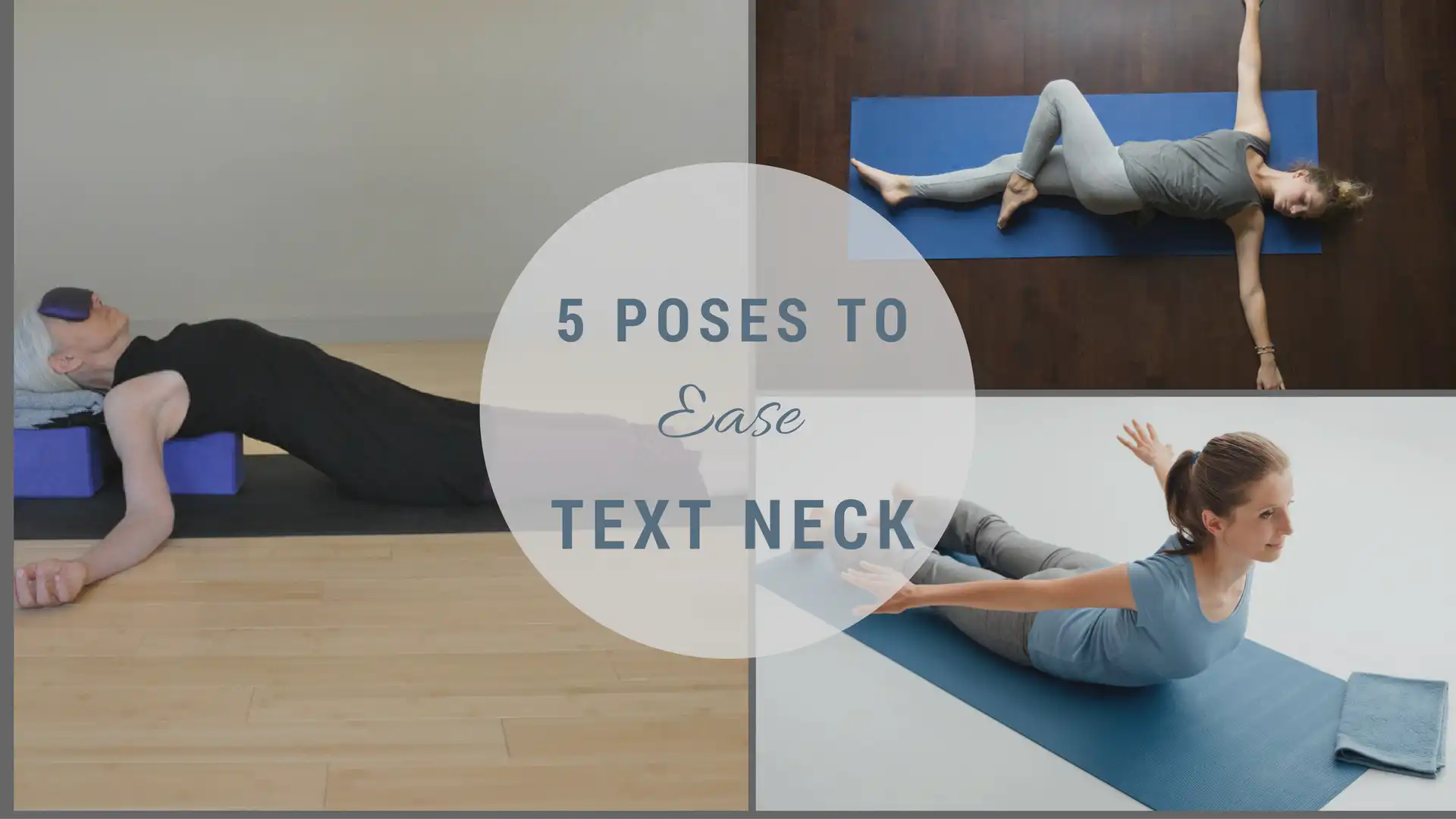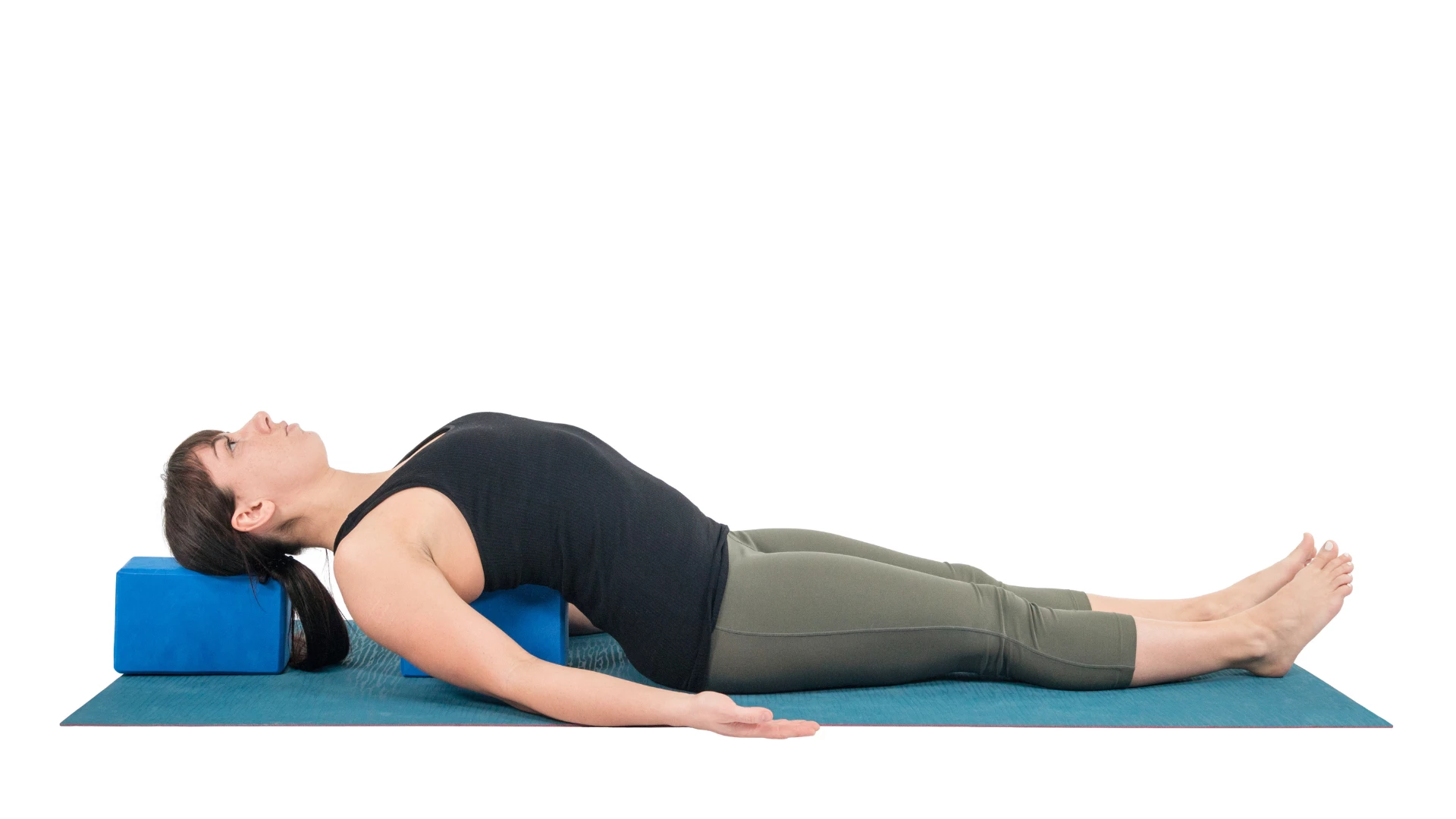5 Yoga Poses to Ease Text Neck

Have you ever noticed what happens to your body when you’re staring at your smartphone or tablet? If you’ve been looking down for a while, your head gradually drops forward, then your shoulders droop, and your back rounds. After a while, you might feel aches and pains in your neck, shoulders, or spine.
People now spend an average of two to four hours a day with their heads tilted forward as they check emails, send texts, read, and play games on their wireless devices (1). All this time we’re spending with our heads down has a big impact on our bodies. It’s led to a constellation of symptoms that have become so common that a term has been coined for them: “text neck.”
As the head tilts farther forward, the spine is forced to bear incrementally increasing weight. Eventually, the cervical spine loses its natural curve. This can lead to increased stress on the neck muscles, excessive wear and tear on the spine, disc degeneration, and, in severe cases, even surgery (1).
How Yoga Combats Text Neck

How does yoga help with this modern-day malady? On a physical level, the practice of yoga asana (postures) can bring your head and spine back into alignment. The spine resumes its natural curvature, and your ears align over your shoulders. This optimal postural alignment leads to less strain on the intervertebral discs. Asana practice also strengthens the muscles of your neck and back, which allows you to maintain a more healthy posture on a daily basis.
On a deeper level, yoga cultivates bodily awareness. One of the essential components of a yoga practice is pratyahara or sensory withdrawal. When you practice pratyahara, you draw your attention inside your body. You notice physical sensations as they arise, and observe them as they fall away. In so doing, you train yourself to be more attuned to how your body feels from moment to moment.
Once you take this practice off the mat and into your daily life, you’ll naturally be more aware of how your body feels. You’ll notice when you’ve been staring at your phone too long and your chin begins to droop and your back hunches. This simple awareness goes a long way toward avoiding the physical pain that results from poor posture.
Here are a few simple poses that will ease the pain if you suffer from text neck.
Yoga for Text Neck Pain: Supported Fish Pose (Salamba Matsyasana)

Supported Fish Pose is THE essential counter-pose for text neck! It’s the exact opposite of the chin forward, shoulders hunched, back rounded posture that results from prolonged texting. It’s also a gentle, restorative pose, so you can spend lots of time in it.
Benefits:
- Opens and stretches the muscles along the front of the neck, throat, shoulders, chest, and ribs
- Softens and releases the belly and thighs
- Calms and relaxes the body and mind
Contraindications:
- Be careful coming in and out of the pose if you have a neck or lower back injury
Place one block on its lowest height at the back edge of your mat. Place the second block at the same height a few inches in front of it. Sit on your mat in front of the blocks, facing away from them with your knees bent and the soles of your feet on the floor. The short edge of the blocks should be facing your back body. Supporting yourself with your hands and abdominal muscles, lie back over the blocks. One block should sit between your shoulder blades, beginning at the mid back and spreading to the upper back. Rest your head on the other block. If you feel any strain in your neck, flip the block under your head onto its medium height. If you’d like a bigger backbend with more intensity, flip both blocks to their medium height. Let the legs and arms rest wherever they feel comfortable and relaxed. Stay here, breathing naturally, for five to ten minutes.
To come out of the pose, bend your knees and place the soles of your feet on the floor. Carefully roll over to your right side, coming off the blocks, and rest on the floor for a few moments in a fetal position. Set your left hand on the floor in front of you and push down into that hand to bring yourself up to sit. Keep your head heavy on the way up; it should be the last thing to arrive.
Mountain Pose (Tadasana)

The foundation of all standing poses, Tadasana epitomizes perfect posture—ears aligned over shoulders, spine long and neutral, and shoulders back and relaxed.
Benefits:
- Improves posture
- Strengthens legs, knees, ankles, abdomen, and buttocks
Contraindications:
- Low blood pressure
Stand with the bases of your big toes touching, heels slightly apart, and second toes parallel. If you find it difficult to balance with the feet together, place the feet wider apart. Lift and spread all ten toes, then return them to the floor. Rock a little bit side-to-side and forward and back. Gradually sway less and less until you come to stillness, with your weight balanced between the balls of your feet and heels and between your right and left foot. Once your weight is evenly rooted, lift the inner arches of your feet and feel how this creates a current of energy that draws up through your legs. Feel the energy continue to draw upward from the legs to the pelvis, through the spine, and finally through the crown of the head. Engage your thigh muscles by lifting your kneecaps without clenching. Gently hug your navel back toward your spine and find a neutral pelvis—neither tucked under nor tilted back. Release your shoulder blades down your back. Keeping your lower ribs in, lift your sternum. Align the crown directly over the center of your pelvis, your ears over your shoulders, and your chin parallel to the floor. Spend five to ten breaths here.
Downward-Facing Dog Pose (Adho Mukha Svanasana)

When you practice Down Dog with your head in neutral alignment, it may counteract the damage done by text neck and re-articulate the natural curve of the cervical spine. But be careful: if you let your head hang down toward the floor, Down Dog could exacerbate the symptoms of text neck. Aim to keep your head in line with your spine.
Benefits:
- Lengthens the spine while also integrating its natural curves
- Strengthens the muscles of the back and neck
- Opens the muscles along the backs of the legs and the shoulders
- Strengthens arms and legs
Contraindications/Cautions:
- Uncontrolled high blood pressure
- Detached retina or glaucoma
- Wrist, shoulder, hip, back, ankle injuries—exercise caution
Begin in a downward-facing tabletop position on your hands and knees, with wrists under shoulders and knees under hips. Place your hands so that your wrist creases are parallel to the top edge of the mat. Maintaining this, step your hands forward slightly, spread your fingers and palms, and tuck your toes under. Slowly straighten your legs, at the same time reaching your hips up to the sky, pushing the tops of your thighs back, and pressing your heels toward the floor. If the spine moves out of its neutral position and rounds, bend your knees enough to maintain length in your spine. Press your chest toward your thighs while extending through your arms. Imagine a long line running from the base of your spine through the crown of your head. After several breaths, return to Tabletop.
Locust Pose (Shalabhasana) to Strengthen Back Body Muscles

Shalabhasana is one of the most effective poses for building strength in the muscles all along the back body. This strength enables you to stand and sit with better posture.
Benefits:
- Strengthens the muscles of the back body, along the spine, buttocks, and backs of the arms and legs
- Improves posture
Contraindications/Cautions:
- Back injury
- Neck injury—exercise caution and be especially careful to maintain a neutral position of the head
Lie on your belly with your forehead on the floor, arms by your sides, and legs about hip-width behind you. Untuck your toes so the tops of your feet are on the floor. Lengthen your tailbone toward your heels to bring the pelvis into a neutral position. Slightly internally rotate your thighs and lengthen your legs behind you as you press the tops of your feet into the floor. Lift the head, upper torso, and arms, turning your palms to face your body and firming your shoulder blades against your back. Keep reaching through your lower limbs toward the wall behind you as you float your feet and legs away from the floor. Create an even sensation along the backs of your legs and through your lower, middle, and upper back. Keep your head in line with your spine by tucking your chin and looking slightly down rather than forward. After several breaths, slowly return to the floor.
For Text Neck Pain, Try Supine Abdominal Twist (Jathara Parivartanasana variation)

Jathara Parivartanasana is the perfect way to unwind the body and mind, especially after long periods of looking down at your smartphone or sitting in front of a computer.
Benefits:
- Rotates the spine
- Wrings out the body from the core
- Stretches the hips and spine
- Eases neck and back tension
Contraindications/Cautions:
- Recent or chronic injury to hips or spine
Lie on your back, with your knees bent and your feet on the floor. Pressing down into your feet, lift your hips, shift them slightly to the right, and place them back down. Draw your knees toward your chest and lower them to the left. Spread your arms into a T-shape on the floor. If it feels good, turn your head to look past your right fingers. If that strains your neck, look up at the ceiling instead. Take several breaths here before returning knees and hips to the center. Repeat on the other side.
Another article brought to you by Christine Malossi and YogaUOnline – 6 Yoga Poses to Counteract the Effects of Sitting.
Study with YogaUOnline and Doug Keller – The Wisdom of Jalandhara Bandha: Neck Health and Why It Matters.

Christine Malossi, RYT 200, is based in New York City, where she offers a mindful, alignment-focused Vinyasa practice that cultivates balance, awareness, and equanimity. In addition to teaching private clients and group classes at studios throughout Manhattan, she also teaches at the Spencer Cox Center for Health at Mount Sinai Hospital’s Institute for Advanced Medicine, where she designs a practice specifically tailored to patients diagnosed with HIV and other chronic illnesses. Christine is honored to be teaching yoga and to have the opportunity to pass on to others the joy and freedom she has found in her practice. Find her at www.christinemalossi.com




